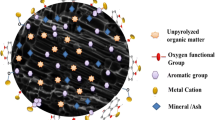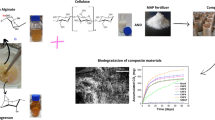Abstract
CO2 is known as a major attractant for many arthropod pests which can be exploited for pest control within novel attract-and-kill strategies. This study reports on the development of a slow-release system for CO2 based on calcium alginate beads containing granular corn starch, amyloglucosidase and Saccharomyces cerevisiae. Our aim was to evaluate the conditions which influence the CO2 release and to clarify the biochemical reactions taking place within the beads. The amyloglucosidase was immobilized with a high encapsulation efficiency of 87% in Ca-alginate beads supplemented with corn starch and S. cerevisiae biomass. The CO2 release from the beads was shown to be significantly affected by the concentration of amyloglucosidase and corn starch within the beads as well as by the incubation temperature. Beads prepared with 0.1 amyloglucosidase units/g matrix solution led to a long-lasting CO2 emission at temperatures between 6 and 25 °C. Starch degradation data correlated well with the CO2 release from beads during incubation and scanning electron microscopy micrographs visualized the degradation of corn starch granules by the co-encapsulated amyloglucosidase. By implementing MALDI-ToF mass spectrometry imaging for the analysis of Ca-alginate beads, we verified that the encapsulated amyloglucosidase converts starch into glucose which is immediately consumed by S. cerevisiae cells. When applied into the soil, the beads increased the CO2 concentration in soil significantly. Finally, we demonstrated that dried beads showed a CO2 production in soil comparable to the moist beads. The long-lasting CO2-releasing beads will pave the way towards novel attract-and-kill strategies in pest control.








Similar content being viewed by others
References
Bernklau E, Bjostad L (1998) Reinvestigation of host location by western corn rootworm larvae (Coleoptera: Chrysomelidae): CO2 is the only volatile attractant. J Econ Entomol 91:1331–1340
Beuchat LR (1983) Influence of water activity on growth, metabolic activities and survival of yeasts and molds. J Food Protect 46:135–141
Chan ES et al (2011) Effects of starch filler on the physical properties of lyophilized calcium-alginate beads and the viability of encapsulated cells. Carbohyd Polym 83:225–232
Chang MY, Juang RS (2005) Activities, stabilities, and reaction kinetics of three free and chitosan-clay composite immobilized enzymes. Enzyme Microb Tech 36:75–82
Cordoba AL, Deladino L, Martino M (2013) Effect of starch filler on calcium-alginate hydrogels loaded with yerba mate antioxidants. Carbohyd Polym 95:315–323
Dashevsky A (1998) Protein loss by the microencapsulation of an enzyme (lactase) in alginate beads. Int J Pharm 161:1–5
Doane JF, Lee YW, Klingler J, Westcott ND (1975) The orientation response of Ctemcera destructor and other wire worms (Coleoptera: Elateridae) to germinating grain and to carbon dioxide. Can Entomol 107:1233–1252
Drapron R (1985) Enzyme activity as a function of water activity. In: Multon JL (ed) Properties of water in foods. Springer, Berlin, pp 171–190
Eldin MSM, Seuror EI, Nasr MA, El-Aassar MR, Tieama HA (2011) Affinity covalent immobilization of glucoamylase onto ρ-benzoquinone activated alginate beads: I. Beads preparation and characterization. Appl Biochem Biotech 164:10–22
FAO (2002) Compendium addendum 10/FNP 52 Add.10/9 vol 1/93
Favaro L, Viktor MJ, Rose SH, Viljoen-Bloom M, van Zyl WH, Basaglia M, Cagnin L, Casella S (2015) Consolidated bioprocessing of starchy substrates into ethanol by industrial Saccharomyces cerevisiae strains secreting fungal amylases. Biotechnol Bioeng 112:1751–1760
Garcia R (1962) Carbon dioxide as an attractant for certain ticks (Acarina: Argasidae and Ixodidae). Ann Entomol Soc Am 55:605–606
George M, Abraham TE (2006) Polyionic hydrocolloids for the intestinal delivery of protein drugs: alginate and chitosan—a review. J Control Release 114:1–14
Gillies M (1980) The role of carbon dioxide in host-finding by mosquitoes (Diptera: Culicidae): a review. Bull Entomol Res 70:525–532
Giordano RLC, Trovati J, Schmidell W (2008) Continuous production of ethanol from starch using glucoamylase and yeast co-immobilized in pectin gel. Appl Biochem. Biotech 147:47–61
Glare T, Caradus J, Gelernter W, Jackson T, Keyhani N, Kohl J, Marrone P, Morin L, Stewart A (2012) Have biopesticides come of age? Trends Biotechnol 30:250–258
Gopinath S, Sugunan S (2007) Enzymes immobilized on montmorillonite K 10: effect of adsorption and grafting on the surface properties and the enzyme activity. Appl Clay Sci 35:67–75
Gouin S (2004) Microencapsulation: industrial appraisal of existing technologies and trends. Trends Food Sci Tech 15:330–347
Hahn-Hägerdal B (1984) An enzyme coimmobilized with a microorganism—the conversion of cellobiose to ethanol using β-glucosidase and Saccharomyces cerevisiae in calcium alginate gels. Biotechnol Bioeng 26:771–774
Hahn-Hägerdal B (1985) Comparison between immobilized Kluyveromyces fragilis and Saccharomyces cerevisiae coimmobilized with β-galactosidase, with respect to continuous ethanol production from concentrated whey permeate. Biotechnol Bioeng 27:914–916
Hou H-P, Yan Y-W (2009) Co-immobilization of glucoamylase and yeast by adsorption-embedment method. Food Sci 30:201–204
Jadhav SB, Singhal RS (2014) Pullulan-complexed α-amylase and glucosidase in alginate beads: enhanced entrapment and stability. Carbohyd Polym 105:49–56
Kaplan F, Guy CL (2005) RNA interference of Arabidopsis beta-amylase8 prevents maltose accumulation upon cold shock and increases sensitivity of PSII photochemical efficiency to freezing stress. Plant J 44:730–743
Kimura A, Robyt JF (1995) Reaction of enzymes with starch granules - Kinetics and products of the reaction with glucoamylase. Carbohyd Res 277:87–107
Klein J, Stock J, Vorlop KD (1983) Pore size and properties of spherical Ca-alginate biocatalysts. Eur J Appl Microbiol 18:86–91
Kusunoki K, Kawakami K, Shiraishi F, Kato K, Kai M (1982) A kinetic expression for hydrolysis of soluble starch by glucoamylase. Biotechnol Bioeng 24:347–354
Lacey LA, Grzywacz D, Shapiro-Ilan DI, Frutos R, Brownbridge M, Goettel MS (2015) Insect pathogens as biological control agents: back to the future. J Invertebr Pathol 132:1–41
Li PH, Weiser CJ, Van Huystee R (1965) Changes in metabolites of red-osier dogwood during cold acclimation. J Amer Soc Hort Sci 86:723–730
Mansfeld J, Dautzenberg H (1997) Coimmobilization of enzymes and cells. In: Bickerstaff GF (ed) Immobilization of enzymes and cells. Humana Press, New Jersey, pp 319–326
McGhee JE, Carr ME, Stjulian G (1984) Continuous bioconversion of starch to ethanol by calcium-alginate immobilized enzymes and yeasts. Cereal Chem 61:446–449
Miller GL (1969) Use of dinitrosalicylic acid reagent for determination of reducing sugars. Anal Chem 31:426–428
Morris VJ, Gunning AP, Faulds CB, Williamson G, Svensson B (2005) AFM images of complexes between amylose and Aspergillus niger glucoamylase mutants, native, and mutant starch binding domains: a model for the action of glucoamylase. Starch-Stärke 57:1–7
Mota M, Teixeira JA, Yelshin A (2001) Immobilized particles in gel matrix-type porous media. Homogeneous porous media model. Biotechnol Progr 17:860–865
Oh JT, Kim JH (2000) Preparation and properties of immobilized amyloglucosidase on nonporous PS/PNaSS microspheres. Enzyme Microb Tech 27:356–361
Pancholy SK, Rice EL (1973) Soil enzymes in relation to old field succession: amylase, cellulase, invertase, dehydrogenase, and urease. Soil Sci Soc Am J 37:47–50
Robyt JF (2009) Enzymes and their action on starch. In: BeMiller JN, Whistler RL (eds) Starch chemistry and technology. Academic, London, pp 237–292
Roy I, Gupta MN (2004) Hydrolysis of starch by a mixture of glucoamylase and pullulanase entrapped individually in calcium alginate beads. Enzyme Microb Tech 34:26–32
Salvado Z, Arroyo-Lopez FN, Guillamon JM, Salazar G, Querol A, Barrio E (2011) Temperature adaptation markedly determines evolution within the genus Saccharomyces. Appl Environ Microb 77:2292–2302
Sandhu KS, Singh N (2007) Some properties of corn starches II: Physicochemical, gelatinization, retrogradation, pasting and gel textural properties. Food Chem 101:1499–1507
Sanroman A, Murado MA, Lema JM (1996) The influence of substrate structure on the kinetics of the hydrolysis of starch by glucoamylase. Appl Biochem Biotech 59:329–336
Schumann M, Patel A, Vidal S (2013) Evaluation of an attract and kill strategy for western corn rootworm larvae. Appl Soil Ecol 64:178–189
Schumann M, Patel A, Vemmer M, Vidal S (2014a) The role of carbon dioxide as an orientation cue for western corn rootworm larvae within the maize root system: implications for an attract-and-kill approach. Pest Manag Sci 70:642–650
Schumann M, Toepfer S, Vemmer M, Patel A, Kuhlmann U, Vidal S (2014b) Field evaluation of an attract and kill strategy against western corn rootworm larvae. J Pest Sci 87:259–271
Selvakumar P, Ashakumary L, Helen A, Pandey A (1996) Purification and characterization of glucoamylase produced by Aspergillus niger in solid state fermentation. Lett Appl Microbiol 23:403–406
Shetty RM, Lineback DR, Seib PA (1974) Determining the degree of starch gelatinization. Cereal Chem 51:364–375
Shukla G, Varma A (2011) Soil enzymology. Soil biology, vol 22. Springer, Heidelberg
Silva RN, Asquieri ER, Fernandes KF (2005) Immobilization of Aspergillus niger glucoamylase onto a polyaniline polymer. Process Biochem 40:1155–1159
Slade L, Levine H (1991) Beyond water activity: Recent advances based on an alternative approach to the assessment of food quality and safety. Crit Rev Food Sci 30:115–360
Smallegange RC, Schmied WH, van Roey KJ, Verhulst NO, Spitzen J, Mukabana WR, Takken W (2010) Sugar-fermenting yeast as an organic source of carbon dioxide to attract the malaria mosquito Anopheles gambiae. Malar J 9:292
Smith JS, Lineback DR (1976) Hydrolysis of native wheat and corn starch granules by glucoamylases from Aspergillus niger and Rhizopus niveus. Starch-Stärke 28:243–249
Svensson B, Ottesen M (1981) Entrapment of chemical derivatives of glycoamylase in calcium alginate gels. Carlsberg Res Commun 46:13–24
Tanaka H, Kurosawa H, Kokufuta E, Veliky IA (1984) Preparation of immobilized glucoamylase using Ca-alginate gel coated with partially quaternized poly(ethyleneimine). Biotechnol Bioeng 26:1393–1394
Taylor L (1963) Analysis of the effect of temperature on insects in flight. J Anim Ecol 32:99–117. doi:10.2307/2520
Trovati J, Giordano RC, Giordano RLC (2009) Improving the performance of a continuous process for the production of ethanol from starch. Appl Biochem Biotech 156:506–520
Van Zyl WH, Bloom M, Viktor MJ (2012) Engineering yeasts for raw starch conversion. Appl Microbiol Biot 95:1377–1388
Velings NM, Mestdagh MM (1995) Physico-chemical properties of alginate gel beads. Polym Gels Net 3:311–330
Vemmer M, Patel AV (2013) Review of encapsulation methods suitable for microbial biological control agents. Biol Control 67:380–389
Vemmer M, Schumann M, Beitzen-Heineke W, French BW, Vidal S, Patel AV (2016) Development of a CO2 releasing co-formulation based on starch, Saccharomyces cerevisiae and Beauveria bassiana attractive towards western corn rootworm larvae. Pest Manag Sci 72:2136–2145
Wang JP, Zeng AW, Liu Z, Yuan XG (2006) Kinetics of glucoamylase hydrolysis of corn starch. J Chem Technol Biot 81:727–729
Wang JZ, Wu DM, Zhao GH, Li MR, Li YF, Han Y, He AX, Jiang Y (2014) Reversible immobilization of glucoamylase onto magnetic polystyrene beads with multifunctional groups. Process Biochem 49:845–849
Wootton M, Bamunuarachchi A (1978) Water binding capacity of commercial produced native and modified starches. Starch-Stärke 30:306–309
Zakhartsev M, Yang XL, Reuss M, Portner HO (2015) Metabolic efficiency in yeast Saccharomyces cerevisiae in relation to temperature dependent growth and biomass yield. J Therm Biol 52:117–129
Acknowledgements
We would like to thank T. Dellweg from Deutsche Hefewerke GmbH (Nürnberg, Germany) for providing baker’s yeast strain S. cerevisiae H205.
Funding
This study was supported by means of the German Federal Ministry of Food and Agriculture (BMEL) as part of the project ATTRACT (No. 2814701811).
Author information
Authors and Affiliations
Corresponding author
Ethics declarations
Conflict of interest
The authors declare that they have no conflict of interest. The authors alone are responsible for the content and writing of the paper.
Rights and permissions
About this article
Cite this article
Humbert, P., Vemmer, M., Giampà, M. et al. Co-encapsulation of amyloglucosidase with starch and Saccharomyces cerevisiae as basis for a long-lasting CO2 release. World J Microbiol Biotechnol 33, 71 (2017). https://doi.org/10.1007/s11274-017-2237-2
Received:
Accepted:
Published:
DOI: https://doi.org/10.1007/s11274-017-2237-2




